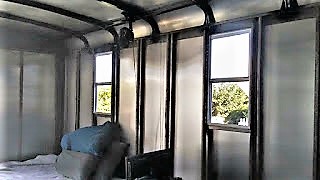My Chemical-Free House on “Cargo Trailer Conversion”
September 30, 2017
Corinne Segura wrote an article about converting a cargo trailer into a comfortable living space on her blog My Chemical-Free House.
From the article:
Erik Johnson is the pioneer of cargo trailer living. He called his trailer and camper MECUs (Mobile Environmental Containment Unit). Erik used EPS foam without flame retardants. I don’t know how he sourced this but I would think this is the kind used for packing, not insulation. In Erik’s trailer, he left a gap (like I did) between the foam and the exterior. He put in weep holes at the bottom in case condensation did find its way to the back. Some trailer like mine come with weep hole. He has said that there has not been any condensation at the back and he has had this for more than a decade. I put the insulation in front of the frame which created a space naturally behind it (though my floors and ceiling have no space). In my third attempt, I’m going to put the floor insulation under the trailer.
He has an interesting (non-toxic) method of putting up the foam: Erik says: “I riveted small strips of aluminum to the steel wall studs that are four inches long. For two sheets of two-inch styrofoam. Put the styro in place and riveted one-inch aluminum angle to the four-inch strip, using the “L” of the angle to secure the styrofoam. This vertical angle then gave me a place on the wall to attach shelves.” This eliminates the need for spray foam, caulking or tape to seal up or hold up the foam, it also means it’s not air tight. This has not been a problem for Erik. Though I was worried in my set up about it not being a perfect vapour barrier. Erik used wooden floors and not metal.
Links on this page are in orange (no underlining).




